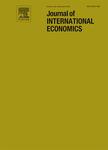-
作者:Das, SP
摘要:This paper examines the implications of delegation of quantity or price setting power to the managers by the firm owners, for trade policy. Delegation reduces the scale of strategic trade policy in an exporting industry. In an import-competing oligopoly industry, the optimal tariff is less or greater than the standard optimal tariff depending on whether firms compete in quantity or price. A quantitative import restriction is collusive even when firms compete in quantities, and induces the home...
-
作者:Bartolini, L; Drazen, A
作者单位:University System of Maryland; University of Maryland College Park; National Bureau of Economic Research
摘要:We present a model where policies of free capital mobility can signal governments' future policies, but the informativeness of the signal depends on the path of world interest rates. Capital flows to emerging markets reflect investors' perception of these markets' political risk. With low world interest rates, emerging markets experience a capital inflow and engage in a widespread policy of free capital mobility; with higher rates, only sufficiently committed countries allow free capital mobil...
-
作者:Noland, M
-
作者:SannaRandaccio, F
摘要:This paper examines the welfare effects of eliminating non-tariff barriers (NTBs), when firms expand abroad via export or direct investment (DI). Two broad categories of NTBs are considered according to whether they discriminate only against the foreign exporter (Type I) or also against the local subsidiary of the foreign-owned firm (Type II). It is shown that the welfare impact of market integration depends upon its influence on firms' international strategies and that such influence is a fun...
-
作者:Amano, RA; Wirjanto, TS
作者单位:University of Waterloo
摘要:We examine the importance of intertemporal substitution in U.S. import consumption using a model of permanent income that allows for random preference shocks and additive separability. The latter feature allows us to take two estimation approaches. In the first approach, we show that there is a cointegrating restriction imposed by the first-order conditions of the model which allows us to estimate the intertemporal elasticity of imported and domestic goods consumption. In the second approach, ...
-
作者:Calvo, GA; Mendoza, EG; Rogers, JH; Rose, AK
-
作者:Yi, SS
摘要:Consider an environment in which ex-ante symmetric countries can form customs unions freely. What are the welfare effects on member and non-member countries of the formation of welfare-maximizing customs unions? What are the properties of stable customs-union structures? Can one design a rule of customs-union formation which, supports global free trade as an equilibrium outcome? I show that the formation of customs unions improves the aggregate welfare of member countries but reduces the welfa...
-
作者:Chao, CC; Yu, ESH
作者单位:Chinese University of Hong Kong; Oregon State University
摘要:This paper provides a general equilibrium model for examining the individual as well as the joint effects of export requirements and local equity controls of multinational firms. The results suggest that for a small open economy under tariff protection, the desirable policy is 100% foreign ownership of subsidiaries, coupled with an export-share requirement.
-
作者:Song, EY
摘要:This paper investigates the effects of voluntary export restraints (VERs) in the presence of potential entrants and technology transfers. It builds a model of a licensing game in a Cournot oligopoly market, and examines conditions under which VERs induce restrained foreign firms to transfer technologies to potential suppliers. I show that a VER can decrease the profit and output of the domestic incumbent by perturbing the no-licensing equilibrium reached under free trade and inducing the marke...
-
作者:Harrigan, J
摘要:How open are the advanced economies to trade with each other? In this paper, openness is calculated relative to the predictions of the monopolistic competition trade model using data on manufacturing trade and production in the OECD in 1985. The paper finds that (1) Japan imports much less than other large OECD countries, while the European countries have larger import volumes than does the US, (2) Japan and the US engage in less intra-industry trade than the rest of the OECD, and (3) the EU c...
